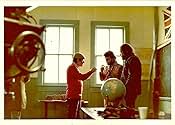Ajouter une intrigue dans votre langueIn the 1930's, Max Brown is an urban young man from an Eastern province, fresh from college, whose only job offer is in a one-room school house in the Canadian prairie. At first he's distant... Tout lireIn the 1930's, Max Brown is an urban young man from an Eastern province, fresh from college, whose only job offer is in a one-room school house in the Canadian prairie. At first he's distant, superior, lonely, and bewildered; his students are rebellious. Over the course of the ye... Tout lireIn the 1930's, Max Brown is an urban young man from an Eastern province, fresh from college, whose only job offer is in a one-room school house in the Canadian prairie. At first he's distant, superior, lonely, and bewildered; his students are rebellious. Over the course of the year, he is drawn to Alice Field, the wife of a farmer, in a love that can lead nowhere. But... Tout lire
- Director
- Writers
- Stars
- Prix
- 1 victoire et 2 nominations au total
Avis en vedette
In terms of style, I noticed that the people living in U.S. and the Praires during the 30s differed quite a bit. Some of the clothes and hairstyles that the women wore were similar, but the people of the Prairies were "country folk," and dressed more appropriately for their lifestyles. Alice, for example,(played by Samantha Eggar), wore the sleek, wavy, side-parted bob that many women of the era chose to sport. However, the difference in economic status was apparent in her attire. The aprons and plain skirts she wore had less appeal than the more elegant blouses and dresses that other women preferred.
In conclusion, the movie was pretty effective in getting its message out to the audience. Bud Cort proved his acting skills alongside his pupils, and many important issues were discussed with respect to the conditions of the schools at the time, and Mr. Brown's personal experiences with Prairie weather. The movie was humorous, with a bit of drama, and still maintained a fair amount of accuracy in portraying life in the 1930s.
-A. W.
I adored the story line! Bud Cort plays an innocent, scattered, simple/warm-hearted man who tries to teach students in a small town in Canada. At first the students are disrespectful loud-mouths, but grow to become compassionate individuals when Cort's character (Max Brown) inspires them.
I cannot get over how endearing Bud Cort is in this film. All he wants is to be loved, and to love someone else, but he has a failed romance with an already-married woman, who is also lost in her own troubles. All you want to do is sympathize with his character, especially in the beginning, when he was trying to become adjusted to this unfamiliar town with people who couldn't understand him.
I would say that this is one of Bud Cort's top 5 best film roles. (Along with Harold and Maude, Bernice Bobs Her Hair, Brave New World, and Ted and Venus).
So in other words, this movie is good for a history class that is covering the 1920's-1930's depression because it gives an accurate description of the events in the prairies.
However the movie lacks strong does not expand on certain issues. For instance, it would have been interesting to know how many persons came out West during the depression. Or how this migration affected the prairies. Providing these details would have made the movie more informative to watch.
VG
Le saviez-vous
- AnecdotesThe film takes place in 1935.
- Citations
Inspector Wood: This should be an easy one. What is the capital of Canada?
Inspector Wood: [pointing to a student in the classroom] Yes, boy.
Charlie Mc Dougall: [standing to attention] The capital of Canada is C.
- ConnexionsFeatured in Cruel, Usual, Necessary: The Passion of Silvio Narizzano (2024)
Meilleurs choix
Détails
- Date de sortie
- Pays d’origine
- Langue
- Aussi connu sous le nom de
- Zašto da ubijemo učitelja
- Lieux de tournage
- sociétés de production
- Consultez plus de crédits d'entreprise sur IMDbPro
Box-office
- Budget
- 810 000 $ (estimation)
Contribuer à cette page






















